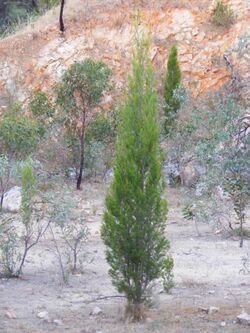Biology:Callitris preissii
| Callitris preissii | |
|---|---|

| |
| Callitris preissii sapling in Adelaide, South Australia | |
| Scientific classification | |
| Kingdom: | Plantae |
| Clade: | Tracheophytes |
| Clade: | Gymnospermae |
| Division: | Pinophyta |
| Class: | Pinopsida |
| Order: | Cupressales |
| Family: | Cupressaceae |
| Genus: | Callitris |
| Species: | C. preissii
|
| Binomial name | |
| Callitris preissii Miq.
| |
| Synonyms[2] | |
| |
Callitris preissii is a species of conifer in the family Cupressaceae, endemic to Rottnest Island, Australia . Common names include Rottnest Island pine, Murray pine, maroong, southern cypress pine, and slender cypress pine. The Noongar peoples know the tree as marro.[3]
Description
The pine can have a tree or shrub-like habit typically growing to a height of 1 to 9 metres (3 to 30 ft) and a width of up to 6 metres (20 ft).[4] It is relatively slow growing. The crown is commonly made up fine, dense foliage.[5] The leaf is rounded on the dorsal side and the cones often have a width of over 2 centimetres (0.8 in) with scales that do not separate from the base. It starts producing brown-yellow-orange cones between October and January.[4] The root system is generally moderate to deep or shallow and spreading. It is reasonably long lived, usually to over 15 years of age.[5]
Distribution
It is endemic to the Swan Coastal Plain, Rottnest Island and Garden Island[5] but has become naturalised elsewhere and now has a scattered distribution throughout the Mid West, Wheatbelt, Peel, Great Southern and Goldfields-Esperance regions where it is found on plains, slopes, the margins of salt lakes and among granite outcrops growing in sandy, loamy or clay soils.[4]
Uses
The plant makes a good windbreak or as a shelterbelt or shade for stock. The trunks make ideal fence posts and it has good ornamental attributes. The plant's pollen has value for apiculture. In urban areas it makes a good ornamental plant, or as a free street tree and is suitable as a screen or hedge.
References
- ↑ Thomas, P. (2013). "Callitris preissii". IUCN Red List of Threatened Species 2013: e.T42207A2961510. doi:10.2305/IUCN.UK.2013-1.RLTS.T42207A2961510.en. https://www.iucnredlist.org/species/42207/2961510. Retrieved 15 November 2021.
- ↑ The Plant List: A Working List of All Plant Species, http://www.theplantlist.org/tpl1.1/record/kew-2692900, retrieved 27 February 2017
- ↑ "Noongar names for plants". kippleonline.net. http://www.kippleonline.net/bobhoward/plantsframe.html. Retrieved 24 November 2016.
- ↑ Jump up to: 4.0 4.1 4.2 "Callitris preissii". FloraBase. Western Australian Government Department of Parks and Wildlife. https://florabase.dpaw.wa.gov.au/browse/profile/96.
- ↑ Jump up to: 5.0 5.1 5.2 "Callitris preissii". Fact Sheet. FloraBank. http://www.florabank.org.au/lucid/key/species%20navigator/media/html/Callitris_preissii.htm. Retrieved 13 October 2018.
Wikidata ☰ Q2715203 entry
 |


